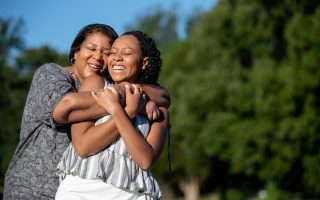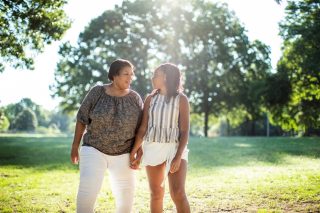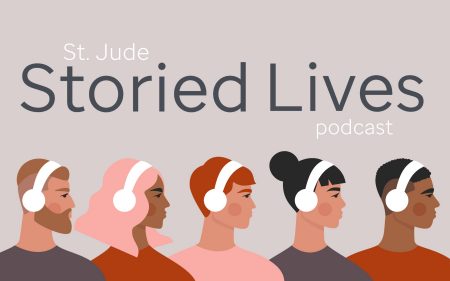
An Ivy League student in a class of her own
Diagnosed with sickle cell in utero, Courtney faced obstacles with the help of St. Jude, mom

June 12, 2020 • 5 min

To understand her mom’s reaction when Courtney declared she wanted to go a thousand miles away for college — “this nonsense,” as Audrey now calls it, with good humor — you have to go back to the beginning.
Actually, before the beginning.
Six months into her pregnancy, a test showed Audrey’s baby would be born with sickle cell disease. There was a family history: A nephew had died from complications of sickle cell at age 3. So Audrey wanted the test. She wanted to know so she could prepare, so she could give her baby every chance to thrive with a disease that can cause chronic, sometimes debilitating pain.
And Courtney has thrived, thanks to St. Jude Children’s Research Hospital. “I tell people I thank God, and I thank St. Jude second-most, for, really, all aspects of her life,” Audrey said.
Because St. Jude wasn’t just a healing place for Courtney. It’s where she learned to read, in that difficult summer between first and second grade, as she struggled with the cognitive side effects of her disease.
It’s where her personality “bloomed” — her mom’s word — as the chance to participate in St. Jude fundraising events drew out this once-timid girl who went from “being afraid of everything and everybody,” to an impromptu singing performance on stage in a ballroom full of people.
Or, as Courtney said, with a laugh, “And then one day somebody at ALSAC (the fundraising and awareness organization for St. Jude) handed me a microphone, and apparently they couldn’t get it away ever since.”
Sickle cell disease did not define her. She wasn’t about to let it confine her: As a high school senior in Memphis she was accepted at Cornell University. Think of it — an Ivy League education for a girl whose mother once worried “the child would never read.”
Now mom was worried about other things. About things of great consequence to the parent of a sickle cell patient, like geography. Cornell is in Ithaca, New York, a thousand miles from Memphis and the support system with which Courtney grew up. A thousand miles from mom, and St. Jude.
“I tried to discourage her by telling her, ‘Courtney, you know when you get sick, I’m not going to be able to blink and be sitting there holding your hand in the hospital.’” Audrey said.
And there was the weather. Winters can be harsh in Ithaca, and cold weather can trigger pain episodes in sickle cell patients. It was so cold the first time Courtney visited campus that she had to borrow a heavy coat from the girl with whom she was staying — and that was in October.
“I said, ‘Don’t you think that should be a concern, that you need a big ol’ coat in October, and you have sickle cell disease?’” Audrey said.
Nothing would dissuade Courtney. Nothing would dim her hopes. But Audrey had one more card to play — St. Jude.
So when they went to see her doctors, to talk about this nonsense of Courtney’s big college adventure, Audrey remembers thinking: “Here we go. St. Jude has always provided my solution to every problem in my life. They’re going to sit this child down and tell her she should not be going off to this cold-weather world.”
In retrospect, mom might have seen it coming. She might have guessed the place that had cared for her daughter throughout her young life — the place that had seen her struggle and overcome — would now champion Courtney in this bold, new chapter.
The reaction at St. Jude?
Oh, my God, Courtney’s going to Cornell! Oh, we’re so proud of you! We’re going to find you a doctor up there, don’t you worry. We’re going to take care of you, you’ll be fine.
Audrey laughs, looking back.
“I’m like, wait a minute. I was depending on you all.”

Pain and bravery
We see a bald child and we think: Chemotherapy. Cancer.
We see that picture of suffering and it helps us understand, at least a little.
But what does pain — sickle cell pain — look like? How does it feel?
Courtney herself struggled to describe it. Then, waiting her turn to speak about the disease at an event one year, another sickle cell patient likened it to “someone hitting your joint with a hammer over and over again.”
“And I can remember I was so shocked,” Courtney said, “because someone had so perfectly described something I had struggled to describe for so long.”
Sickle cell disease is an inherited blood disorder in which red blood cells, which should be round, instead become sickle-shaped, and have difficulty passing through small blood vessels.
Between that medical definition and the hammer-on-joint analogy lies the reality for some 100,000 people in the U.S. with sickle cell disease, most of them African Americans.
Their experiences with pain vary. Some have frequent episodes. Some episodes are mild to moderate, and can be managed at home. Others are severe and require hospitalization. To live with sickle cell disease is to live carefully, mindful not just of fevers and infections, but something as seemingly benign as winter.
St. Jude, best known for its work on pediatric cancer, has been researching sickle cell disease since the hospital’s founding in 1962. The first research grant to St. Jude was for the study of sickle cell disease, and today the hospital operates a groundbreaking clinic to help 18-year-old patients make the transition from St. Jude to adult-care facilities.
Courtney, 19, says she has “good weeks and bad weeks,” but calls herself “incredibly blessed in my journey with sickle cell,” compared with those whose pain is more frequent and severe.
As for the Ithaca winter, well, nobody lied about that. “To have that first winter, to walk around in negative 2 degrees weather,” she said, “it was definitely a shock to my body, and just my everyday life.”
But for about seven months — until March, when the pandemic sent students everywhere home — Courtney persevered and prospered. She made good friends and great grades. She found a new support system to go with her old one.
There was pain, there were fevers. But she did NOT call home crying for her mother to come hold her hand.
Courtney was living carefully, as sickle cell patients must. But she was also living bravely, boldly, as our biggest dreams tend to demand.

One Proud Mom
Mothers know best, even when they don’t.
Or put another way, Audrey may have been overly protective in wanting Courtney to stay closer to home for college. But think of the daughter she raised — a girl who hasn’t just learned to cope with sickle cell disease, but rise above it.
“My mom had been preparing me my entire life,” Courtney said, “whether I was going an hour away or 14 hours away.”
Mom doesn’t take credit, of course. She thanks God and St. Jude, and marvels at Courtney’s maturity in her freshman year so far from home, amid the ice and ivy of Cornell.
“We don’t have her grades from this semester, but last semester she made all A’s,” Audrey said. “Being a million miles away from us, little Southern belle girl at an Ivy League school, upstate New York, freezing cold, didn’t know anybody in the world.
“And she figured out how to go and make friends, get to know people, and make grades that just blew our minds.
“I’m still like, how’d that happen?”








